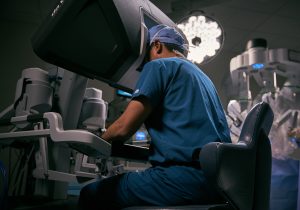Robotic-Assisted Surgery
Frequently Asked Questions
What is robotic-assisted surgery?
 Robotic-assisted surgery is a method of minimally invasive surgery performed by a surgeon operating several precision-guided robotic arms that hold and manipulate miniaturized instruments, inserted through very small incisions (8-13 mm). A small video camera provides surgeons with magnified 3D images (10X magnification) of the operating site. This magnified view allows doctors to see and avoid surrounding nerves and muscles. The robotic arms, which can rotate 360 degrees, enable surgical instruments to be moved with greater precision, flexibility and range of motion than in standard minimally invasive laparoscopic surgeries.
Robotic-assisted surgery is a method of minimally invasive surgery performed by a surgeon operating several precision-guided robotic arms that hold and manipulate miniaturized instruments, inserted through very small incisions (8-13 mm). A small video camera provides surgeons with magnified 3D images (10X magnification) of the operating site. This magnified view allows doctors to see and avoid surrounding nerves and muscles. The robotic arms, which can rotate 360 degrees, enable surgical instruments to be moved with greater precision, flexibility and range of motion than in standard minimally invasive laparoscopic surgeries.
What is the difference between laparoscopic surgery and robotic-assisted surgery?
Laparoscopic surgery is performed by hand, with the help of a 2D camera. Robotic-assisted surgery allows your surgeon to operate extremely precise instruments from outside the patient’s body, using a console and a highly magnified, 3D camera.
Is robotic-assisted surgery safe?
This surgical technology has been approved by the FDA since 2005 and hundreds of studies have been published on the use of robotic surgical systems demonstrating improved surgical outcomes when compared to laparoscopic or open surgeries. Over 7 million surgeries have been performed worldwide using the da Vinci Surgical System.
Does a robot perform the surgery?
The robot does not perform the surgery without control from the surgeon. The surgeon goes through extensive training to become familiarized with the robotic arm movements. The surgeon’s hands guide the robot’s arms and miniaturized instruments during the surgery to precise movements inside the human body.
What are the advantages of robotic-assisted surgery?
Robotic-assisted surgery enables a high level of patient care, efficient processes in clinical settings, and better patient outcomes including:
- Shorter hospital stay
- Faster recovery to normal daily activity
- Reduced pain and discomfort
- Less blood loss
- Reduced scarring
- Reduced narcotic pain medication use post-surgery
Does insurance cover the cost of robotic-assisted surgery?
Most insurance plans include robotic surgery in their minimally invasive coverage. You should consult your insurance plan or your insurance representative for exact coverage.
Does Medicare cover the cost of robotic-assisted surgery?
As long as your surgery is deemed necessary, Medicare should cover expenses relating to robotic surgery. Your own individual coverage will depend on your plan and benefits package, so you should consult your individual Medicare coverage plan or a representative for more information.
What procedures will be performed using the da Vinci robotic-assisted surgery system?
- Hernia
- Gall Bladder
- Hysterectomy
- Ovary Removal
- Endometriosis
- Prostate Issues
Is robotic-assisted surgery right for me?
SMH surgeons work closely with you in discussing options and helping you decide the best surgical method for your treatment.

Big Horn Surgical
Phone: 307.673.3181
Fax: 307.673.3180
Outpatient Center
1333 West 5th St, Suite 111
Sheridan, WY 82801
Women’s Clinic
Phone: 307.672.2522
Outpatient Center
1333 West 5th St, Suite 210
Sheridan, WY 82801
